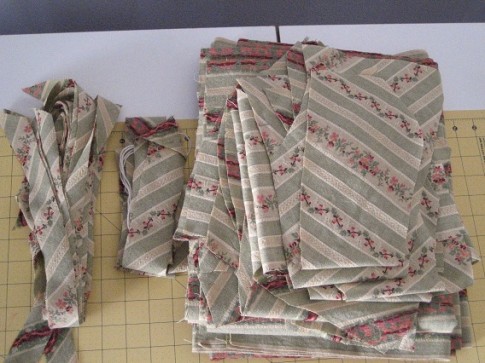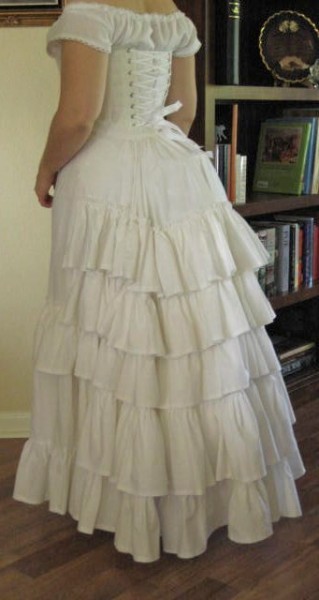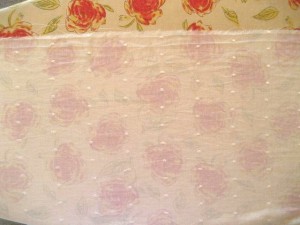
Do you have a type of fabric that just calls to you? You know, the type that even though you’re looking for something completely different in the fabric store you just can’t help walking over to it and reveling in its deliciousness. Yeah, me too. It’s called cotton.
I am the Cotton Girl. I LOVE cottons.
I gave myself that name in high school because everything I sewed was from cotton – dresses, shorts, tops, curtains, vanity toppers, pillows. It was actually difficult to choose a fancier fabric for my prom dress, which I made from poly moiré. But the lining was cotton!
Cotton is a versatile textile providing comfort, luxury, easy sewing ability, warmth, coolness, breathability, washability and strength. We can use it for undergarments all the way out to bonnets, trims and outerwear.

Types of Cotton Fabrics and Their 19th C. Costume Uses (not an exhaustive list)
- Batiste – chemise, drawers, corset covers, Regency day & evening dresses, undersleeves, collars & cuffs (with sturdy underlining), trims, bustle aprons, summer dresses
- Broadcloth – bustle underskirts, 1890s summer skirts, hoopskirts & bustles
- Calico – mockups, petticoats, sunbonnets 1830s to 1880s day dresses
- Chintz or Polished Cotton – bodice & skirt underlinings
- Corduroy – men’s trousers & waistcoats/vests, capes, belts, 1890s skirts & vests
- Coutil – corsets, bodice underlinings
- Damask – 1840s to 1860s ball gowns, 1880s & 90s skirts and bodice accents, waistcoats/vests
- Dotted Swiss – Regency day & evening dresses, undersleeves, bustle day dresses, 1890s blouses
- Eyelet – petticoats, undersleeves, 1850s to 1880s day dresses
- Flannel – drawers, under petticoats, coat/jacket linings
- Lawn – chemise, drawers, shirtwaists/blouses, Regency day dresses, bustle dresses
- Muslin – mockups, underlinings, chemise, drawers, petticoats, corded petticoats, hoopskirts & bustles, undersleeves, collars, cuffs
- Organdy – petticoats, corded petticoats, collars, cuffs, underlinings, 1830s to 1880s summer dresses, belt lining, bonnet/hat lining, hem facings, trim support
- Poplin – bustle underskirts, bodice underlinings, sheer skirt linings
- Sateen – waistcoats/vests and their linings, bodice linings, coat/jacket linings, late Victorian bodices depending on the weight
- Shirting – petticoats, 1870s to 1890s day dresses, shirtwaists/blouses
- Twill – hoopskirts & bustles, bodice underlinings, bustle underskirts, 1890s skirts, Regency spencer & pelisse, cape/cloak/paletot lining
- Velveteen – Regency spencer & pelisse, capes/cloaks, belts, 1870s to 1890s bodices, skirt accent fabric, trims, bonnets
- Voile – Regency day & evening dresses, summer dresses, shirtwaists/blouses, undersleeves

Regency costumes all in cotton (from left): drop-sleeve shirt in muslin, waistcoat in ivory damask (one color), breeches in corduroy, the lovely Sharon Lathan in the middle, dress in windowpane gauze, open robe in twill.
Watch out for cotton/poly blends as they are everywhere and are sweepingly sold as all cotton. Broadcloth, eyelet and voile especially. These and others can contain as much as 65% or more polyester. Although not forbidden to use, they are not historically accurate. And the poly doesn’t breathe like cotton which makes for an uncomfortable time in the many layers of costume pieces.
As mentioned in the Part 2 – Wool post, I HIGHLY recommend Julie Parker’s All About Cotton: A Fabric Dictionary & Swatchbook as a valuable tool to sewing with cotton fabrics. Your sewing bookshelf should not be without it!
(For Part 1 – Linen click here)

Treating Cotton Fabric
All cotton fabric should definitely be pre-treated before cutting and sewing. Cotton is known for its shrinkage (you know, how your jeans are tighter when they’re freshly washed). You want to avoid your tightly fitted garments shrinking to the point where you can’t get them on anymore.
Cotton can be washed in warm or cold. Warm water will shrink it a bit more. The fabric can be air dried or thrown into the clothes dryer.
As a test to see how much the textile is reduced, cut 2 exact swatches and wash one with the fabric. Compare the 2 swatches. All fabrics are varied and some will shrink both along the grain and on the cross. You may also notice the swatch shrink further in one direction or another. This could indicate a blended textile or simply the warp and weft threads were handled differently in the weaving process.
Cotton fabric usually continues to shrink after repeated washings. Make note of this when sewing certain garments. Air drying will help slow this inevitable course.

Pressing cotton requires a hot iron and steam. As with the nature of this textile, you will have wrinkles and creases. After washing, dry but leave damp then press. This will help to get most of the wrinkles out. You can also use a spray water bottle to dampen the fabric while pressing.
(Before making a garment) don’t fret if you can’t get out all the wrinkles. Press the fabric as well as you can. When you are constructing your item, pressing as you go will get more creases out.
Cotton naturally rumples. Expect it. Work with it as is and be satisfied. Remember everyone else who is wearing cotton is also thinking about the wrinkles in their dress.
Where to Buy Cotton Online
Get samples if you can. Start your own swatchbook so you can learn to identify the various cotton textiles available.
Also keep other obscure sources in mind for obtaining cotton fabric – use ready-made drapes and sheets. Tablecloths work too. Or simply wander around your local fabric or quilting store. Cottons are quite abundant.
The list here is not exhaustive, merely places I’ve found over the years that carry cotton. I have not purchased from all of the vendors listed so do proper research before buying.
Updated October 2018
Burnley & Trowbridge – Tell Angela you found her here!
Denver Fabrics – nice selection of many fabrics
Dharma Trading Co. – good quality fabrics ready for dyeing
Farmhouse Fabrics – delicious cottons of all sorts
Hancock Fabrics (now owned by Michael’s)– a national large fabric store
JoAnn Fabrics – the usual generic fabric store
Maggie May’s Historic Clothing – 100% cotton reproduction prints
Payless Fabric – carries hard to find polished cotton
Renaissance Fabrics – Tell Diana you found her here!
Reproduction Fabrics – excellent selection of period appropriate designs
Spoonflower – make your own fabric; most offerings are in cottons
You no doubt have historical costumes made from cotton. Tell us your favorite in the comments below!


I have a slight alternative to suggest to the “wash a swatch” check for shrinkage. I mark a measured 6″ square with running stitch in contrasting thread, and then after the wash I can measure how much it shrank, and also check the diagonals to see if they’re still the same or if the piece has skewed in the wash (and if it has, this square can also be used to confirm whether it can be brought back to true by ironing or not). It’s the same idea, but avoids fraying and other edge effects that might influence the measurements of a smaller piece unduly, and also avoids cutting chunks out of my precious, precious fabric earlier than required.
I just found this article and you don’t even know how happy not made me. I just got in to historical sewing, literally made my first piece a week ago, and I’m doing the Historical Sew Fortnightly 2014. I know, way to dive into the deep end no floats. But I bought 4 yards of pink calico cotton yesterday for the upcoming challenge and then was heartbroken that I may have spent $20 on fabric I cannot even use. I’m so glad that calico was used until the 1880s. My dress isndated around 1872 so my skirt should still be historically accurate. Thank you so much!
I’m a little confused about washing polished cotton or any other treated cotton. If I remember correctly, one of your recent FB posts suggested Rain No Stain (TM) curtain lining for petticoats. I was happy to see that because I’d just bought some to line a cotton twill 1890s skirt. Of course the tag says “Dry clean only” but so does almost anything presently for sale, so if it’s silk (NOT taffeta) or cotton or wool, I just wash it. Of course I hand wash the silk and wool. So I just confidently figured the curtain lining would just land in the washing machine. Now I’m not so sure. How do you handle it? BTW, I’m chicken about washing the cotton twill, too.
I pretty much wash all my cottons before sewing. Simply to remove factory oils and to shrink the fibers. If you will dry clean the final garment then you don’t necessarily need to pre-wash the Rain No Stain. (Can’t remember if I did or not but I know I used it on an elaborate bustle skirt and did not pre-wash for that. If it’s for petticoats – definitely pre-wash.) And don’t be afraid to wash twill. It will shrink and doing that before you start working with a hot steam iron on it will save you grief later from patches that shrink and others that don’t due to where & how much steam ironing you apply.
I’m a mostly cotton girl too, but I do allow poly blends for anything that doesn’t actually touch my skin. The first reason is that often 100% cotton is hard to find and when you do it’s sometimes prohibitively expensive (ever priced handkerchief weight? Egyptian?) I hate that it shrinks so much, all too frequently lacks texture and anyway I suck at ironing. Just because my ancestors had to suffer with wrinkles doesn’t mean that I have to–if I can get away without.
I don’t buy anything that’s less than 60% cotton, though. Up to that point it’s almost as breathe-y as the real thing. Recently I’ve also discovered some of the new microfiber fabrics because, again, they do breathe. Besides looking a lot like natural fibers, they also are very soft, they have a nice hand, drape beautifully and they absorb very well. However, I’m VERY picky and I suggest anyone else be picky too.
Sadly, there can be some times when cotton just isn’t going to work. That’s when I look for other natural fibers such as wool and silk. If you can stand it next to your skin there’s also linen, but for me both wool and linen are terribly itchy. If I use them I still line the garment in good ol’ cotton.
From reading the list above I take it that Moire Taffeta is out for a period correct 1880’s bustle dress?
Oh no, not at all! Although moire and taffeta are two different fabrics. For these weaves I recommend 100% silk fiber. Taffeta is not made in cotton and is widely woven from polyester or nylon which I recommend you avoid. You can find moires in silk (expensive) and polyester (again, not recommended) but you might get lucky and find some in a cotton blend. Moire is generally woven in wales or cords whereas taffeta is a very smooth, tightly woven textile.
Another great article, I love printed cottons (I am allergic to wool and only just now getting “into” linen) I found a pillowcase in the same fabric as your Duvet cover at a thrift store, and love it! Where did the duvet come from?
The duvet was purchased from Ikea in 2007 or 2008. I made an 18th C. caraco jacket and have yet to make the matching petticoat. But I have plenty to do so!
After nearly 16 years of searching, I finally found a fabric distributor that sells reproduction cotton prints! And I’m willing to share too! Just contact me for pricing info!
http://www.maggiemayfashions.com/blogfebruary2012.html
Ooh! Some of those are lovely! Do you sell yardage or are they only choices for your reproduction work?
Hi Jennifer-
I absolutely sell by the yard! I know how hard it has been to locate period appropriate/authentic historical prints and I am more than happy to share with everyone!
A little bit about these prints: They are reproduced from historic textile collections across the US and Europe. They are 200+ thread count/100% cotton.
Just send me an email specifying which print you are interested in and your desired quantity! I am pretty sure I can meet or beat ReproductionFabric.com’s pricing!
Happy sewing everybody!
-sj
info@maggiemayfashions.com
I’ve added your link to the Fabric & Trim resource page!
I do like cotton and cotton blends. Modern-day broadcloth is my favorite because (depending on the brand) it breathes like cotton yet resist wrinkles & keeps its color like polyester. This year I want to try linen out, my hubby likes it. Waiting for a good sale.
I am the happiest girl in the world knowing I’m not the only one who loves cotton! Making corset enquiries is a bit embarassing. The makers always have these grand ideas of satin and silk and velvet, and I’m just like, “….I’d like it in nice plain cotton, please….”
At Spoonflower you can design your own or purchase designs you see. There’s a wide variety of stuff (and one I’m going to keep secret for a late Victorian fantasy gown, hehe). Lauren has a few designs that are perfect for late 18th Century and Regency. You’ll find her under American Duchess on Spoonflower: http://www.spoonflower.com/profiles/americanduchess
I realized just recently that I think anyone is able to design their own fabric on Spoonflower.. to offer it for sale! I know American Duchess has a shop on the website with several period-accurate prints she has come up with based on garments from the Kyoto Institute. [Not sure if it is under American Duchess or her name, Lauren Reeser]. This changes everything! Coming up with some of my own based on museum pics or fabric that I wished I could find but can’t for a specific ensemble is now on my mental ‘to do’ costume list.